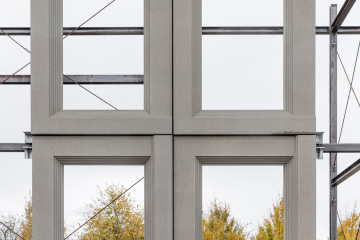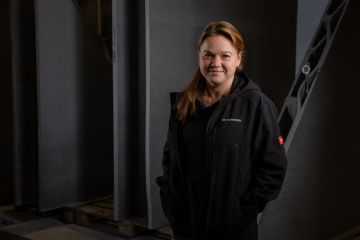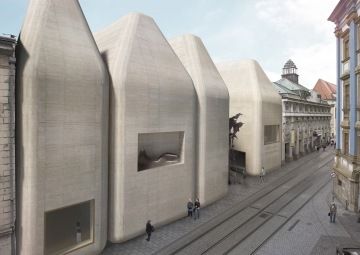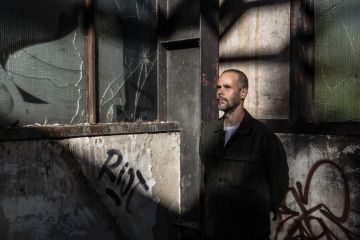
Federico Díaz is a unique artist, technological innovator, and remarkable thinker whose contemplation of the world will resonate with you long after speaking with him. Díaz’s artistic creation lies at the intersection of cutting-edge technology, respect for natural laws, historical development, and represents a crucial building block of the So Concrete project, pushing the boundaries of robotic fabrication. What does concrete mean to him, and what role does he see for artificial intelligence?
Share article
What sparked the creation of So Concrete?
The idea naturally emerged during the process of two creations. One of them was the cladding for the ventilation of the Blanka tunnel, where we were confronted with needing certain materials for a public space object that had to consider the safety of the public. Often, it’s a decision about the material that will resonate with the concept and idea. In this case, it was concrete, which remains functional even if a fire were to break out in the tunnel. At the same time, we were quite limited by time, and when you cannot dedicate several years to a piece as was done in the past, I turn to technology, which is very close to me. Here, it was robotic fabrication that created the entire object. Then came another project connected with architecture in a public space.
The Na Horu project at Bořislavka?
Yes, with the architect Aulík, we created an object where we used the same technology. Over the years, I have often been asked if it would be possible to use it for buildings as such. Today, an architect is very constrained by budgets, materials, and shapes that are readily available. If one wishes to create an ideal shape, it is almost impossible. In this regard, the processes in architecture and sculpture are nearly identical. You have some formwork with a given reinforcement, into which I pour concrete, and thus walls, columns, and ceilings are formed.
These processes have essentially remained unchanged since the Middle Ages, and the construction industry is one of the last sectors of human activity that has not been modernized. It is often dependent on craftsmen, such as carpenters, who are called whenever something needs to be shaped. The moment robotic fabrication technology freed these sectors, both economically and in thought, So Concrete was born. It arose out of necessity, but also as a natural development of technology.
You collaborated with the Klokner Institute at ČVUT on the development of high-strength concrete. What was important in this collaboration?
The type of material I use has existed since around the 1960’s. With the Klokner Institute, we were not dealing with the technology itself but verifying the material’s characteristics for a specific use. Unlike in the free arts, certain rules must be followed in construction, which is why we confirmed the material’s usability in architecture with not only the Klokner Institute but also other accredited laboratories. We did this under the umbrella of the Federico Díaz Studio, so that So Concrete could further develop the idea.
It is something that directly communicates with the robot. When I have something scanned or modeled in 3D, I no longer create it physically in space.
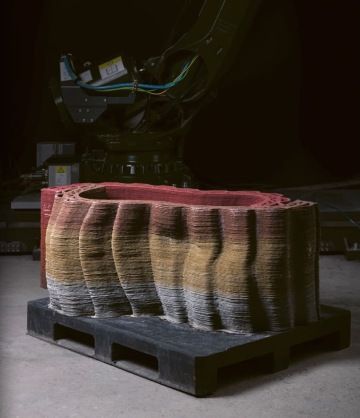
How do you choose materials for your work?
I have been interested in materiality and new materiality for a long time. New materiality, which pertains to an augmented or virtual reality, is a lay er we don‘t have to touch at all. It is something that directly communicates with the robot. When I have something scanned or modeled in 3D, I no longer create it physically in space.
For example, when working on the Na Horu project, I scanned the surface of the gorge, which was located under sediments and was originally one of the oldest trade routes in the Czech Republic. I was going through my personal library of materials. In my case, I cannot go to a store like Bauhaus and buy materials because I do not want to create a scenography where things appear different on the surface than they actually are. The entire sculptural result must reflect the precise character of the materials.
What fascinates you about concrete?
For me, its tension is intriguing. Concrete is essentially a fluid material, and since the time of the Pantheon’s construction, architects have been confronted with gravity, which limits all shaping. Concrete is an additive—it’s gradually added to, unlike carving stone where material is removed. Therefore, the initial sketch or concept is very immaterial; I can’t touch it. However, with current tools, I can model it, and shape something with properties similar to natural structures. In concrete, I see complete freedom and the possibility to create from this liquid stone in a way that mimics how nature creates.
What is the greatest application of digital fabrication in your activities at So Concrete?
The very first inquiries and still the most important projects for So Concrete stem from collaborations with architects. A particularly vibrant project is the Olomouc Museum of Art, where the architect Šépka is trying to insert a completely new shape into an existing gap, and we have been discussing its creation by using digital fabrication for some time. We are also in contact with the architect Winy Maas from MVRDV and others regarding the use of this technology. So, it is mainly architects who are leading the way rather than companies that follow suit.
The demand might also relate to current times, where we face limited urban space and the need to build vertically rather than horizontally...
Absolutely. Often, due to politicians and lobbying, concrete is viewed as unacceptable from a CO2 perspective. However, when viewed through the lens of robotic fabrication, it significantly conserves material (up to 70 percent) and, unlike most materials that do not allow cities to expand vertically, this technology makes it possible. I see robotic fabrication as very space- and nature-friendly. It is also scientifically proven that concrete absorbs CO2. I think it is important not to view concrete through an overly mainstream lens.
Every significant societal transformation has been linked to a certain form of prosperity. This can be at a very simple level, where a person lives in harmony with nature, prospers from something efficient, does not create excessive waste, and does not burden the natural cycle.
How about material durability?
We have learned from the past, for instance, from the example of Baťa’s Zlín, and now we use different types of activators. Our material is designated as UHPC (Ultra-High-Performance Concrete), whose properties are many times better, and thus its durability is also significantly better. Unlike regular concrete, which has an estimated lifespan of about 100–200 years, the life cycle of UHPC can extend to 500 years.
This is a significant technological breakthrough. Could you compare it to any similar moments in history?
Every significant societal transformation has been linked to a certain form of prosperity. This can be at a very simple level, where a person lives in harmony with nature, prospers from something efficient, does not create excessive waste, and does not burden the natural cycle. This technology is groundbreaking in that it eliminates many burdensome circumstances in the process of construction and shaping. Thus, aesthetics, beauty, and design are supported by the form and technology itself, not just the material.
This thoughtful connection with nature has been reflected in your work from the beginning. Why is this symbolism important to you?
I have always wished that people confronted with a given shape would resonate with certain moments without having to read anything about the work. When I approach a piece and observe its surface, I want to think: ‘aha! this is created in a different way.’ I find it important for a certain socio-political discussion, which the work should encourage, while simultaneously unsettling certain stereotypes so we can move forward. I also like to refer back to evolutionary theory, which states that it is characteristic of us as a society to imagine the non-existent. This is how things evolve, both in art and in science.
You studied under Karel Malich, who has greatly influenced you as an artist. How has Malich shaped your thinking about art and the world?
Malich was, of course, absolutely fundamental, mainly because, in high school and even before, no one had told me that there are worlds that can be created without existing and being seen. These are processes that shape our world and can be depicted through art. This was a great encouragement in my work. For example, one of the pivotal moments was the digital structure ‘Geometric Death Frequency–141’ exhibited at the Venice Biennale in the Arsenale in 2011. At that time, I could observe how something emerged over several months solely based on the interaction with visitors and the environment. I had no influence upon it. I look at it as an organism, a natural thing that arises spontaneously. That was very powerful for me.
People generally have a need to keep things under control, whether it’s their life or the environment they move in. Maybe we let things flow too little, much like nature does…
Control is a very interesting topic. We are currently preparing an exhibition of Gothic art, which is more about craftsmanship. I realized that I am looking more at repeating patterns whether from workshops in cities or in villages. Madonna and other thematic representations were created primarily for control. Society has a vision, and if I don’t have other media channels for social engineering besides craftsmanship, images and objects become the means through which I can exert control. This then evolves further. It is a natural process to control one’s territory. It doesn’t have to be a bad thing. However, it is important to occasionally relax control, let the process breathe, and allow it to move forward. So Concrete will also soon be increasingly controlled to fit certain building parameters, etc.
This also relates to Artificial Intelligence and robotic work. To what extent are they controlled by humans, and when do they exhibit autonomous behavior?
The most current automatic production lines can be seen at Tesla, for instance, where 3,500 robots work 24 hours a day. They operate almost autonomously, automatically ordering materials when they run low. They do not need daylight, and you don’t need to pay for their health or social insurance. These robots were originally developed to control the efficiency of human movement and ergonomics.
How do you perceive the role of Artificial Intelligence in creative fields?
In order to exist, we think in linear time. We imagine what is coming and are aware of what has happened before. We cannot envision ourselves across the entire span of time simultaneously, for example, being 80 years old with the responsibilities of a five-year-old. My son is currently five years old and is simultaneously creating his future self at eighty. Artificial intelligence, on the other hand, can operate across all these timelines at once, which makes it incredibly fast. Its ability to analyze in seconds is unmatched. When we aim to self-reflect and analyze aspects of our character, such as in art, AI is very helpful. It is essential for the development of an artist’s, architect’s, or composer’s language and practice.
Do you see Artificial Intelligence as complementary rather than as a complete replacement for creatives?
I view it as complementary because the essence of our existence and the universe is timelessness. With artificial intelligence, we can perceive something that our bodies normally cannot, as we exist only for a certain period. As purely natural beings, we have created artificial intelligence, which cannot truly be artificial because it was created by humans. We develop it out of fear precisely because our existence is temporary, and we have selective memory. Of course, there is also the aspect of control and information dissemination, but above all, it is driven by the fear that our territory at the level of our physical bodies will eventually decay and end.
When you set aside art and technology, do you have a place where you like to disconnect from the world?
Here in the Czech Republic, it’s definitely Šumava with its damp, magically decaying forests. In Europe, I also enjoy Italy, where I am confronted with various structures, whether in nature or in cities. I enjoy returning routinely to the same place to observe how the landscape changes. This again relates to temporality and transformation. And then there’s my home—the view from the window onto the garden, the transition from interior to nature, from shadow to light, and of course, somewhere in between is my family.
Share article
More news
Impact test of facade elements for the OLOE office building
The OLOE office building, which is part of the southern part of Prague's vast new Smíchov City district, will receive a facade, the first segments of which are currently being tested as part of the so-called impact test.
Marie Kovářová, CEO of So Concrete
"Everything is possible when there’s a will. And a good team can achieve much more than any individual," says Marie Kovářová, the new CEO of So Concrete.
A Chance for SEFO
Jan Šépka is one of the most daring architects in the Central European scene. His projects are designed with uncompromising honesty, and push the oundaries of the conventional to the unimaginable.
Share article
More news
Impact test of facade elements for the OLOE office building
The OLOE office building, which is part of the southern part of Prague's vast new Smíchov City district, will receive a facade, the first segments of which are currently being tested as part of the so-called impact test.
Marie Kovářová, CEO of So Concrete
"Everything is possible when there’s a will. And a good team can achieve much more than any individual," says Marie Kovářová, the new CEO of So Concrete.
A Chance for SEFO
Jan Šépka is one of the most daring architects in the Central European scene. His projects are designed with uncompromising honesty, and push the oundaries of the conventional to the unimaginable.
